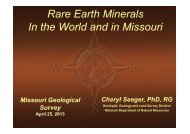Create successful ePaper yourself
Turn your PDF publications into a flip-book with our unique Google optimized e-Paper software.
Black Rock Gap prospect, SE¼SW¼ sec. 32, T.<br />
31 N., R. 91 W., Southeastern Fremont County<br />
The Black Rock Gap prospect is located along<br />
an east-trend<strong>in</strong>g shear zone <strong>in</strong> the north-central<br />
Granite Mounta<strong>in</strong>s. Intensive potassic and propylitic<br />
alteration surrounds the prospect with a 4.6 m<br />
(15 ft) long adit <strong>in</strong> the center of a north-trend<strong>in</strong>g<br />
antiformal structure just west of Black Rock Gap.<br />
The adit follows a 95˚ trend<strong>in</strong>g, near vertical shear<br />
zone, which cuts mafic and ultramafic rocks and<br />
granite gneiss. Brecciation accompanies shear<strong>in</strong>g<br />
<strong>in</strong> some areas. Abundant jasper and epidote are<br />
present near the adit, as is some copper sta<strong>in</strong><strong>in</strong>g.<br />
Epidotization is spread across a wide area near the<br />
prospect and is easily seen <strong>in</strong> aerial imagery. A sample<br />
of sheared ultramafic rock with copper sta<strong>in</strong><strong>in</strong>g<br />
(20121009WS-A) yielded 0.5 ppm (0.015 oz/<br />
ton) gold, 318 ppm cobalt, 516 ppm chromium,<br />
and 1.15 percent copper. A sample of iron-sta<strong>in</strong>ed<br />
fault gouge from the shear zone (20121009WS-B)<br />
yielded 0.51 ppm (0.015 oz/ton) gold, 318 ppm<br />
cobalt, 515 ppm chromium, and 1.575 percent<br />
copper. Two additional samples from the prospect,<br />
20121009WS-C (brecciated mafic rock with<br />
CaCO 3 cement) and 20121009WS-D (severely<br />
altered and brecciated felsic gneiss) yielded 1,200<br />
ppm and 1,630 ppm chromium, respectively.<br />
UT Creek - Lost Muffler Fault Prospects,<br />
NW¼NW¼ sec. 22, T. 32 N., R. 87 W., Northwestern<br />
Natrona County<br />
The UT Creek Formation is generally east-trend<strong>in</strong>g<br />
and <strong>in</strong>cl<strong>in</strong>ed steeply south to near vertical, <strong>in</strong><br />
the northern part of the Saddle Rock quadrangle<br />
(Sutherland and others, 2012). The Archean<br />
UT Creek Formation is dom<strong>in</strong>ated by f<strong>in</strong>e- to<br />
medium-gra<strong>in</strong>ed metagreywackes and tuffaceous<br />
metagreywackes separated by a relatively thick<br />
metavolcanic member that is locally dom<strong>in</strong>ated by<br />
foliated to massive, black, f<strong>in</strong>e-gra<strong>in</strong>ed to aphanitic<br />
metabasalts (Hausel, 1996).<br />
The Lost Muffler fault parallels the general east<br />
trend of the UT Creek Formation and carries<br />
anomalous gold values west of UT Creek (Hausel,<br />
1996) where it is dotted with small prospects.<br />
Near the north side of the fault, east of UT Creek,<br />
and near a contact between metabasalt and metagreywacke,<br />
a prospect pit is dug <strong>in</strong>to sheared<br />
metabasalt cut by iron-sta<strong>in</strong>ed quartz ve<strong>in</strong>s adjacent<br />
to an outcrop of m<strong>in</strong>or black schist. Sample<br />
20120607WS-B is representative of the sheared<br />
metabasalt and associated quartz ve<strong>in</strong>s. Analysis of<br />
this sample showed 1.84 ppm (0.05 oz/ton) gold<br />
and no anomalous REE.<br />
Wagon Bed Formation NW¼SE¼ sec. 30, T. 32<br />
N., R. 88 W., Southwestern Natrona County<br />
The Wagon Bed Formation crops out south of<br />
the North Granite Mounta<strong>in</strong>s Fault <strong>in</strong> the northern<br />
part of the Blackjack Ranch 7.5’ quadrangle.<br />
The Wagon Bed Formation was described by Van<br />
Houten (1964) <strong>in</strong> the Beaver Rim area, about 55<br />
km (34 mi) west of the Blackjack Ranch quadrangle.<br />
Love (1970) further described the Wagon<br />
Bed <strong>in</strong> the central Granite Mounta<strong>in</strong>s. Regionally,<br />
it varies from pale-olive and greenish-gray, tuffaceous<br />
sandstone, siltstone, and mudstone with<br />
some zeolitic ash layers to a highly variable coarse<br />
conglomerate. Outcrops of the Wagon Bed <strong>in</strong> this<br />
area are poorly exposed due to weather<strong>in</strong>g and<br />
slope wash. However, ground disturbances such as<br />
excavations or drill holes provide opportunities to<br />
exam<strong>in</strong>e the lithology of the formation. At this site,<br />
a very recent (2012) drill hole provided subsurface<br />
material from the Wagon Bed Formation. Three<br />
samples were collected here (20121031WS-E,<br />
20121031WS-F, and 20121031WS-G). Cream to<br />
greenish and rusty-orange, very-f<strong>in</strong>e gra<strong>in</strong>ed sandstone<br />
and ash (Sample 20121031WS-F) conta<strong>in</strong>ed<br />
3.15 ppm (0.09 oz/ton) gold.<br />
Wagon Bed Formation Ash Layer, NE¼SE¼ sec.<br />
32, T. 32 N., R. 87 W., Southwestern Natrona<br />
County<br />
The Wagon Bed Formation crops out <strong>in</strong> this<br />
vic<strong>in</strong>ity, where it is dom<strong>in</strong>ated by conglomerates,<br />
sandstones, and ash layers, along with m<strong>in</strong>or silicified<br />
limestone. Conglomerate typical of the Wagon<br />
Bed caps the ridge above and immediately to the<br />
northwest of this location. A tufa deposit from<br />
a paleo-hot spr<strong>in</strong>g (Sample 20120613WS-A) is<br />
underla<strong>in</strong> by 5- to 10-foot thick ash layer (Sample<br />
20120613WS-B). The tufa (Sample 20120613WS-<br />
A) conta<strong>in</strong>s 3.68 ppm (0.11 oz/ton) gold, but the<br />
ash layer conta<strong>in</strong>s no gold. No anomalous REE<br />
were detected <strong>in</strong> either sample.<br />
64



